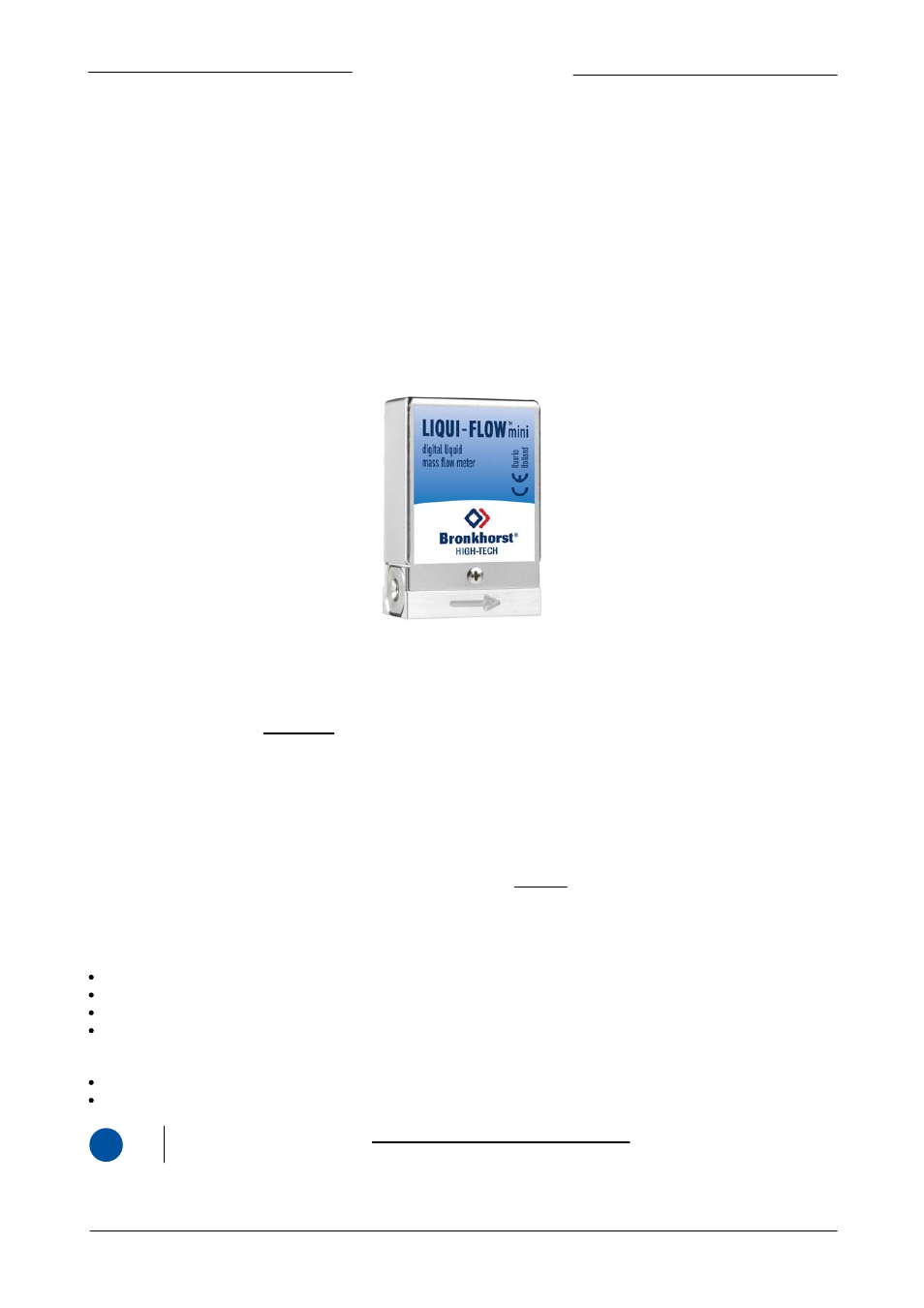1 scope of this manual, 1 introduction, 2 product description – Bronkhorst LIQUI-FLOW mini (from 01-07-2013) User Manual
Page 6: 3 references to other applicable documents, Scope of this manual, Introduction, Product description, References to other applicable documents, 1scope of this manual

LIQUI-FLOW™ mini
9.17.065
Bronkhorst High-Tech BV
6
1
Scope of this manual
1.1
Introduction
This manual covers the LIQUI-FLOW
TM
mini series mass flow meters for micro fluidic flow. An example of the instrument is shown in
the picture below. This manual includes product information, installation instructions, operation, maintainance and
troubleshouting.
LIQUI-FLOW
TM
mini instruments are one of the smallest micro fluidic Mass Flow Meters (MFM) of its kind. The very compact
instruments with dimensions 20 x 40 x 60 mm are capable of measuring ultra low flow rates in ranges starting from 1.5…75 mg/h
up to 12…600 mg/h, based on water. The straight, duplex steel sensor tube (W1.4462) has an internal volume of less than 1 mm
3
and operates on the thermal measuring principle. Due to its high pressure rating of max. 1200 bar (17400 psi) the MFM is suited
for HPLC systems. The instruments are equipped with a microprocessor-based printed circuit board, offering high accuracy and
excellent temperature stability. The RJ45 connection is used for power supply and for both analog and digital (RS232/RS485)
communication.
1.2
Product description
A LIQUI-FLOW
TM
mini flow meter consists of a thermal mass flow sensor with a digital electronic PC-board for sensor enhancement
and communication. The sensor consists of a straight capillary with two heat resistant wires wound around it. The measuring
principle is explained briefly in section 2.14. The sensor signal is measured and digitized directly at the sensor by the PC-board. The
internal software (firmware) processes the signal (linearisation and amplification) to the desired signal level, which is then
translated to the desired output. Each instrument is equipped with an analog and a digital interface, which can be used
simultaneously. Digital operation adds a lot of extra features (compared to analog operation) to the instruments, such as direct
reading at readout/control module or host computer, identification (serial number, model number, device type, usertag) and
adjustable instrument settings.
Communication with the devices can be either in analog mode or digital over RS232 or RS485. Communication over RS232 is
established with the Propar (FLOW-BUS) protocol. With digital operation over RS485 a bus-system with multiple instruments can
be set up. Modbus-RTU/ASCII and FLOW-BUS protocols are supported, see section 3.
1.3
References to other applicable documents
Instructions:
LIQUI-FLOW
TM
mini Quick Installation Guide (document nr. 9.17.066)
Operation instructions digital instruments (document nr. 9.17.023)
RS232 interface with FLOW-BUS for digital instruments (document nr. 9.17.027)
Modbus slave interface for digital Mass Flow / Pressure instruments (document nr. 9.17.035)
Technical drawings:
Hook-up diagram LIQUI-FLOW
TM
mini RS232/RS485 + Analog I/O (document nr. 9.16.097)
Dimensional drawing LIQUI-FLOW
TM
mini (document nr. 7.05.823)
i
www
These documents are available on:
or can be applied for at our local sales & service representatives
